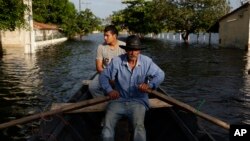Emergency officials said Saturday that as many as 150,000 people in the border areas of Paraguay, Uruguay, Brazil and Argentina had fled their homes ahead of severe flooding from torrential summer rains linked to the El Nino weather phenomenon.
Regional reports said 90,000 residents of the Paraguayan capital, Asuncion, had been evacuated by Saturday evening — many of them families living in substandard housing near the Paraguay River.
In Alberdi, 120 kilometers (75.5 miles) south of Asuncion, the government recommended that 7,000 more families living along the banks of the Paraguay River evacuate.
Paraguay's President Horacio Cartes declared a state of emergency in the capital and several nearby regions to free up funds to help those affected, as government officials toured the area Saturday by helicopter. There were scattered reports of fatalities, but no official death toll had been announced by late in the day.
Argentina's state-run news agency Telam said 20,000 people in the country's northeast had also been forced to flee.
"We are going to have a few complicated months. The consequences will be serious," Ricardo Colombi, governor of the Corrientes region, said after flying over the worst-affected areas with national Cabinet Chief Marcos Pena.
Pena said that national government aid was already on its way and that President Mauricio Macri, who took office this month, intended to make improving infrastructure a priority so that such flooding did not occur again.
"Argentina has a very big lack of infrastructure," he said.
Officials in Uruguay said some 9,000 people near swollen rivers had been forced to leave their homes. Uruguay's national emergency office said it expected water to remain at its current levels for several days before subsiding.
Civil defense authorities in the southeastern Brazilian state of Rio Grande do Sul told The Associated Press that at least 7,000 residents had evacuated.
Brazil's President Dilma Rousseff also flew over the flooded areas on the border with Argentina and Uruguay on Saturday morning. Rio Grande do Sul state civil defense officials said 1,795 people were left homeless there after 38 towns were affected by heavy rains.
Heavy rains began falling in the region last week, part of a transcontinental El Nino weather pattern stretching east and southeast from coastal Ecuador and Peru to the Atlantic.
"We knew it would have its strongest impact toward the end of spring, start of summer ... but we could not know how much," Uruguay Emergency Office Chief Fernando Traversa said.
This year's El Nino, which sparks global climate extremes, is the strongest in more than 15 years, the U.N.'s World Meteorological Organization said last month.
"Severe droughts and devastating flooding being experienced throughout the tropics and subtropical zones bear the hallmarks of this El Nino," WMO chief Michel Jarraud said in a statement.
Scientists have also linked El Nino weather patterns characterized by warmer than normal Pacific coastal currents to unusually warm and violent weather seen in recent weeks in much of the United States.
Some information for this report came from Reuters.










